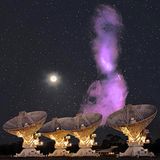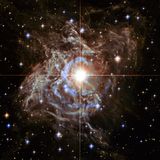
It's official. Someone on an exoplanet has obviously bought a new telescope because it's cloudy there... with a chance of more clouds. Thanks to the powerful range of the Hubble Space Telescope, astronomers have been able to study two of the most common types of planets in the Milky Way and discovered that both are probably swaddled in clouds.

Image: This is an illustration of the hypothetical appearance of the exoplanet GJ 1214b, which is known as a "super-Earth" type planet because it is slightly more than six Earth masses. Spectroscopic observations with NASA's Hubble Space Telescope provide evidence of high clouds blanketing the planet. These clouds hide any information about the composition and behavior of the world's lower atmosphere and surface. The composition of the clouds is unknown. Credit: NASA, ESA, and G. Bacon (STScI)
As far as distances go, the two planets aren't very far away. The first, GJ 436b, is located approximately 36 light-years away in the constellation of Leo and the second, GJ 1214b, makes its home in the constellation of Ophiuchus and is about 40 light-years distant. Try as they might, the researchers had been unable to pinpoint the makeup of the planet's atmospheres--until now. The latest findings are an incredible advancement to understanding the potentially habitable planets similar to Earth which reside beyond our solar system.
Just what are these planets like? According to the researchers, "the two planets fall in the middle range in mass, between smaller, rockier planets such as Earth and larger gas giants such as Jupiter. GJ 436b is categorized as a "warm Neptune" because it is much closer to its star than frigid Neptune is to the Sun. GJ 1214b is known as a "super-Earth" because of its size. Both GJ 436b and GJ 1214b can be observed transiting, or passing in front of, their parent stars. This provides an opportunity to study these planets in more detail as starlight filters through their atmospheres."
This new research includes an atmospheric study of GJ 436b founded on such transit observations with Hubble, led by Heather Knutson of the California Institute of Technology in Pasadena, California. The Hubble spectra were featureless and revealed no chemical fingerprints whatsoever in GJ 436b's atmosphere.
"Either this planet has a high cloud layer obscuring the view, or it has a cloud-free atmosphere that is deficient in hydrogen, which would make it very unlike Neptune," said Knutson. "Instead of hydrogen, it could have relatively large amounts of heavier molecules such as water vapor, carbon monoxide, and carbon dioxide, which would compress the atmosphere and make it hard for us to detect any chemical signatures."
If at first you don't succeed, try again. Observations much like those obtained for GJ 436b had also been documented beforehand for GJ 1214b. The initial spectra of this planet also showed no features, but indicated GJ 1214b's atmosphere was dominated by water vapor or hydrogen, with high-altitude clouds. Using Hubble, astronomers led by Laura Kreidberg and Jacob Bean of the University of Chicago took a closer look at GJ 1214b. A eureka moment? Quite possibly. They discovered what might be evidence of high clouds shrouding the planet and hiding information about the composition and behavior of the lower atmosphere and surface. The new Hubble spectra also revealed no chemical fingerprints in GJ 1214b's atmosphere, but the data sets were so precise they could rule out cloud-free compositions of water vapor, methane, nitrogen, carbon monoxide, or carbon dioxide for the first time.
"Both planets are telling us something about the diversity of planet types that occur outside of our own solar system; in this case we are discovering we may not know them as well as we thought," said Knutson. "We'd really like to determine the size at which these planets transition from looking like mini-gas giants to something more like a water world or a rocky, scaled-up version of the Earth. Both of these observations are fundamentally trying to answer that question."
Original Story Source: Hubblesite News Release
About Tammy Plotner - Tammy is a professional astronomy author, President Emeritus of Warren Rupp Observatory and retired Astronomical League Executive Secretary. She's received a vast number of astronomy achievement and observing awards, including the Great Lakes Astronomy Achievement Award, RG Wright Service Award and the first woman astronomer to achieve Comet Hunter's Gold Status.


















